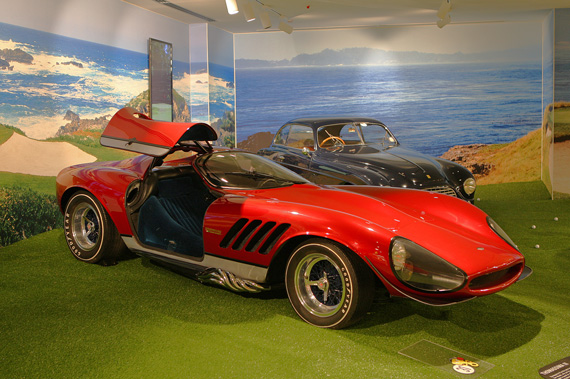
Thomassima. Tom Meade's third creation and probably his most famous. Tom Meade was an American living in Modena who had his own ideas as to how Ferrari's should look. This example is based on a 250GT Coupe.
Story and photos by Jonathan Sharp
The article covers the cars and current displays at the Ferrari Museum. Click here to read about the items and artifacts at the Ferrari Museum
2014, in addition to being the 100th Anniversary of the founding of the Maserati concern is also the 60th anniversary of the presence of Ferrari in North America.
This anniversary also ties in rather nicely with the recent launch of the new Ferrari California T. These two events are currently being celebrated at the Ferrari Museum in Maranello with an exhibition by the name of “California Dreaming”. The display covers five halls, each with a different theme, whether that be racing cars that won in the States, street cars, American-designed one-off’s, and even the films of Hollywood.
The display halls are not as spacious as the main display hall at the Casa Enzo Ferrari Museum in Modena, so the cars do not enjoy the luxury of lots of space around them. This is offset with interesting and exciting backgrounds done with the greatest of style. The “California Dreaming” exhibit ends in late February 2015.
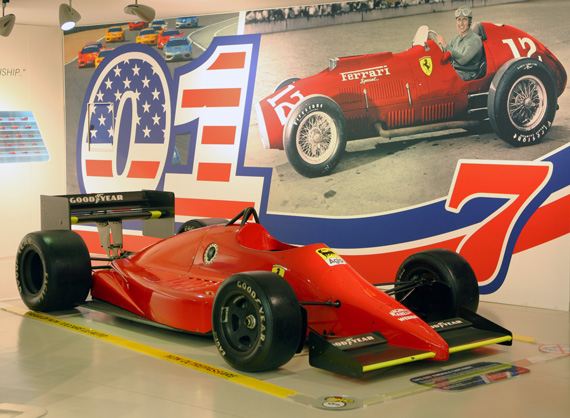
Ferrari CART 637. As was often the case Enzo Ferrari had fallen out with the FIA over the new F1 regulations for 1986. He threatened to leave F1 and race in the CART series in the USA with a desire to win the Indy 500. He went as far as building a car designed by Gustav Brunner, the 637. Power came from a turbo charged 32 valve 90 degree 2.65 liter V8. It never raced and many believe it was used simply as a bargaining tool. The engine lived on though.

Lola Alfa Indy car. The engine from the 637 was later gifted to Alfa Romeo and found a home in a Lola T91/100 chassis. Driven by Danny Sullivan its best finish was 4th in the 1991 session.
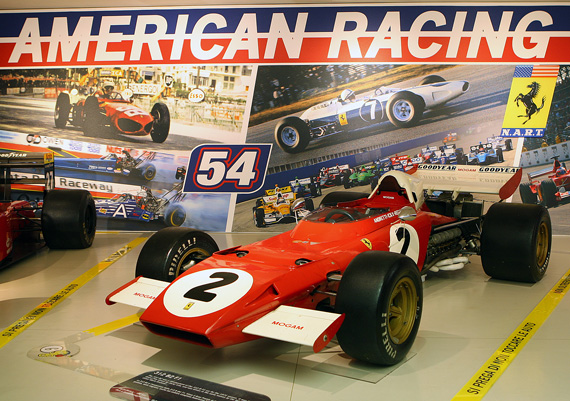
Unveiled in January 1971 but not raced until the Monaco Grand Prix. This B2 won twice in 1971 (Andretti in South Africa and Ickx in Holland) and once in 1972 ( where Ickx beat team mate Regazzoni in Germany).
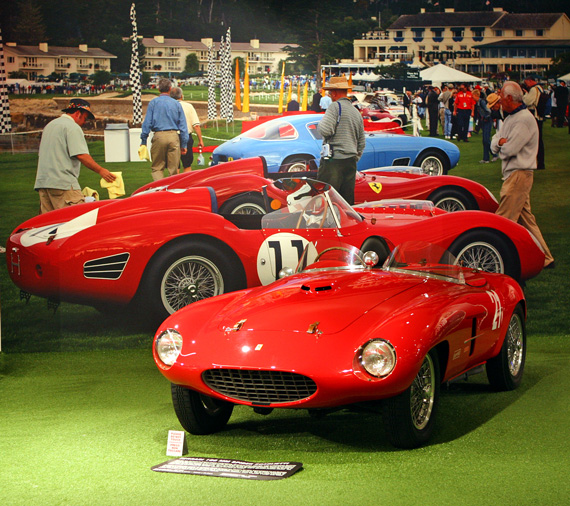
Ferrari 166MM-Spider-Scaglietti. This car was delivered Antoine Causse of Casablanca Morocco in 1953 as a competition Berlinetta by Vignale. In this configuration the car finished sixth in the Tour De France Auto, Following a road accident the car was returned to the factory where the Vignale body was removed and the chassis handed into the care of Enzo Ferrari's son Dino to manage the re body. Dino chose to retain the services of Scaglietti to produce what became the prototype of the 750 Monza and Mondial models.
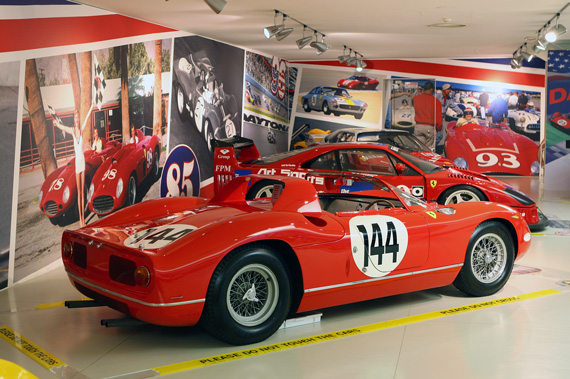
One of only three examples of the P3 built in 1964 and raced by both the factory and also private teams. The 330P is essentially a 275P but with a 4 liter V12 rather than a 3.3 V12.

After 20 years away Ferrari returned to front line sports car racing in 1994 with the 333SP. Powered by 4 liter F1 derived V12 the cars proved successful winning the Sebring 12 hours in 1995, 1997 and 1998, and the Daytona 24 hours race in 1998.
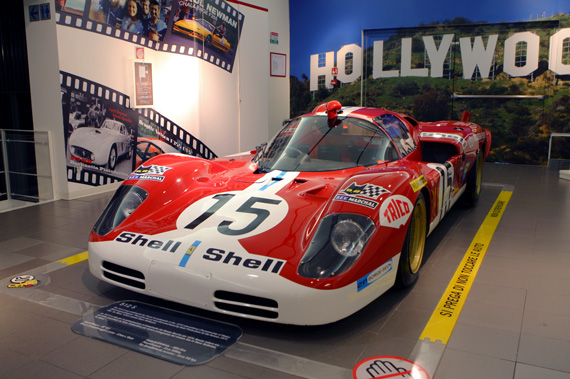
512S Ferrari's have starred in many a Hollywood epic, some great, some not so. A montage was being shown throughout the day in the museum cinema. The 512S Coda Lunga shown here was constructed in 1970 to compete in the championship of makes (sports cars and prototypes). The car was then purchased by Solar productions in 1971 and appeared with Steve McQueen in his epic film Le Mans.
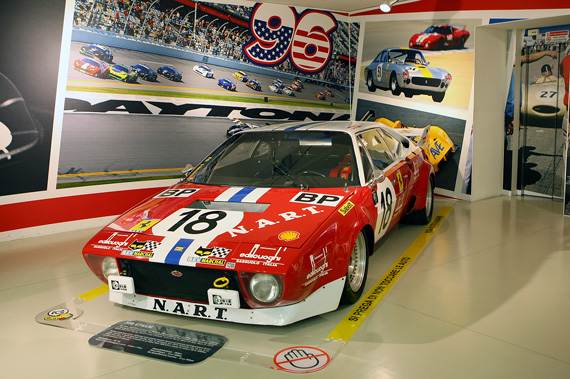
A unique car, built by Luigi Chinetti's North American Racing Team and raced in the Le Mans 24 hour race of 1974. Alas it retired in the fourth hour.
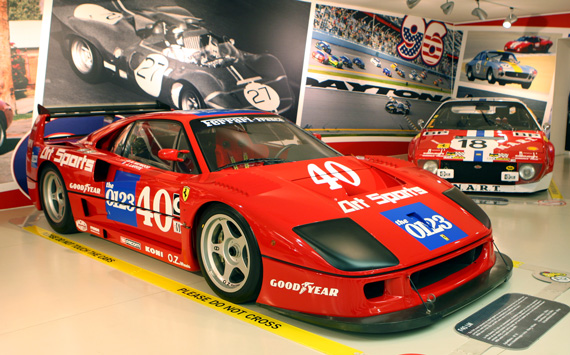
Ferrari F40 LM. The LM version was run in the IMSA series in the USA and the BPR race series in Europe by private teams.

Ferrari Daytona-Comp 365GTB/4 Group 4. Built by the factory in three series of 5 cars each. Class wins at Le Mans in 1972, 73 and 74. Winner of the Tour De France in 1974 and second overall in the Sebring 12 hours of 1979.
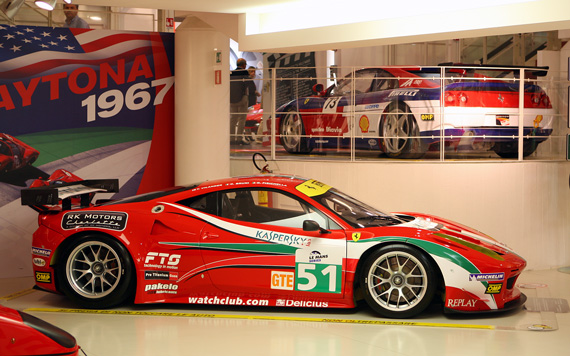
Ferrari GT2 458 of AF Corsa Italia. GTE class winner at the 2012 Le Mans in the hands of Giancarlo Fisichella, Gianmaria Bruni and Toni Vilander.

The F60 was the team’s F1 car for the 2009 season. A season which saw a return to slick tires and the arrival of KERS. Named F60 to celebrate 60 years of continuous participation of the Scuderia in Formula One. Kimi Raikkonen won the Belgium Grand Prix in an F60.
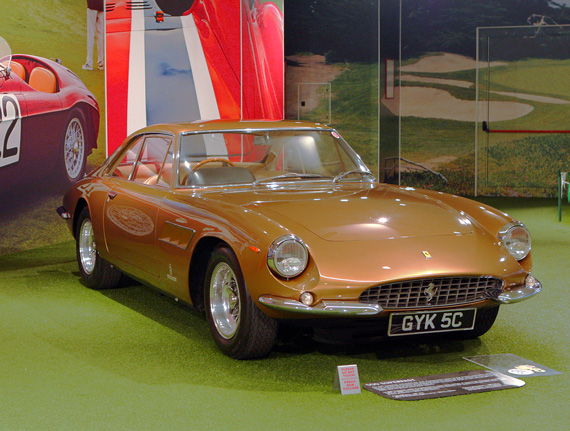
A shot in the dark, but presumably Peter Sellers' 500SF, rhd, three vents, and with the proper plates.
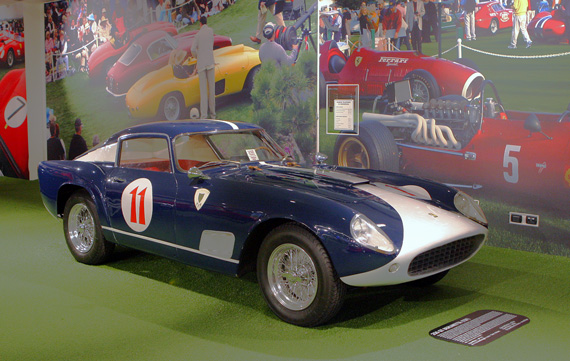
Ferrari 250-GT Most of us call them TDFs but the factory never did. This 250 GT Berlinetta was originally supplied to Scuderia Askolin in Finland where it remains to this day. The car was raced extensively and obtained some impressive results.
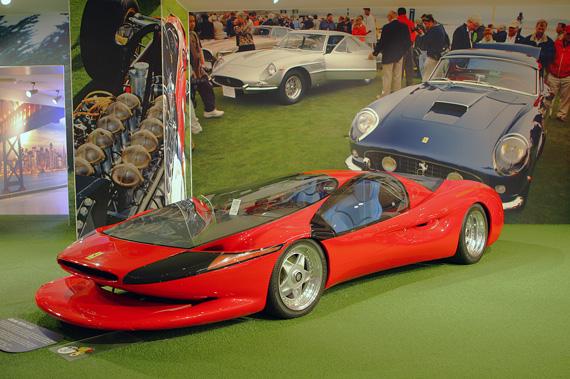
Colani Testa D Oro. Another man's idea as to how a Ferrari should look. Designed by Lutz Luigi Colani and built in collaboration with Lotec racing this car set a world record for cars fitted with catalytic converters of 351 Kms an hour in the hands of Mike Strasborg. Power comes from a 750 bhp twin turbo flat 12 engine.
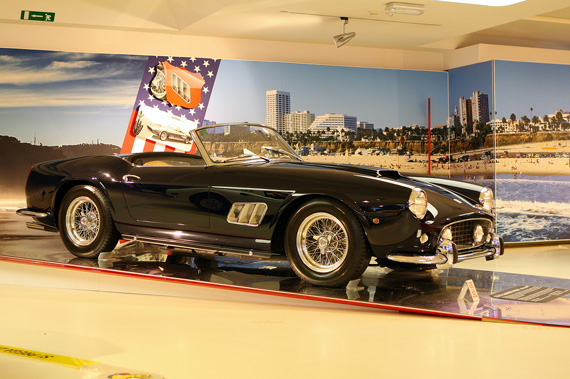
Ferrari 250 GT California Spider Passo Corto Built in long wheel base version from 1958 before changing to the short wheel base (Passo Corto) version in 1960.
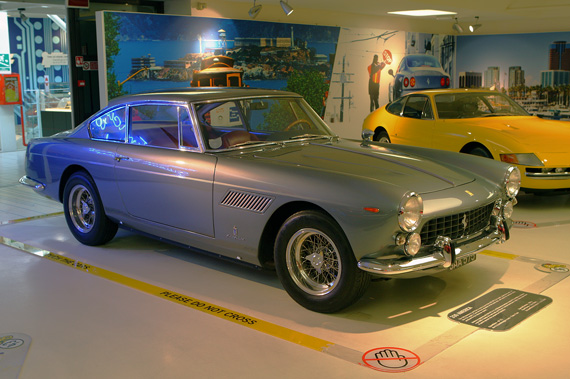
Ferrari 330-America. 330 America, essentially a 250GTE but fitted with a 4 liter V12 rather than the 3.0 of the 250.
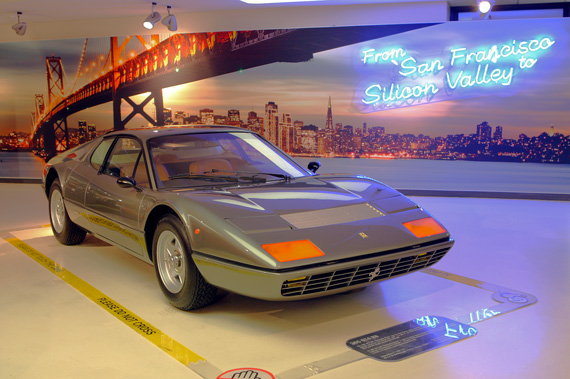
Ferrari 365GT4 BB 4.4 liter flat 12. Looks great in one color rather than a black lower half. Here with a backdrop of San Francisco, the BB was never imported legally into the U.S.
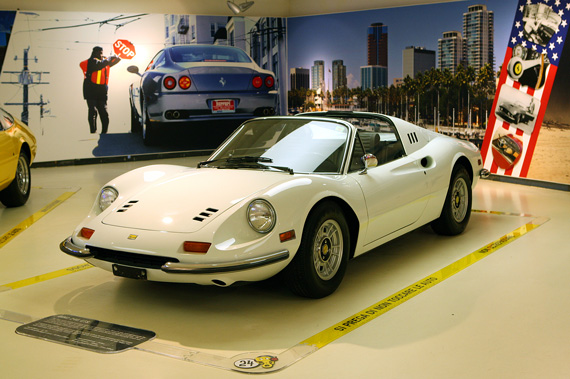
Ferrari 246GTS Dino. Although Ferrari did not put his name on the car, the Dino was a true Ferrari and very popular in the U.S.

Ferrari SA Aperto, A new limited edition open topped model based of the 599 GTB Fiorano. Named to commemorate Sergio and Andrea Pininfarina (the S and A).

La-Ferrari. It is easy to miss this as it is behind a black curtain. You enter a darkened room, then you hear a click, then a V12 roar, then on come the lights and there you are La Ferrari!
Ok, now what is missing and why? Readers? Ed.
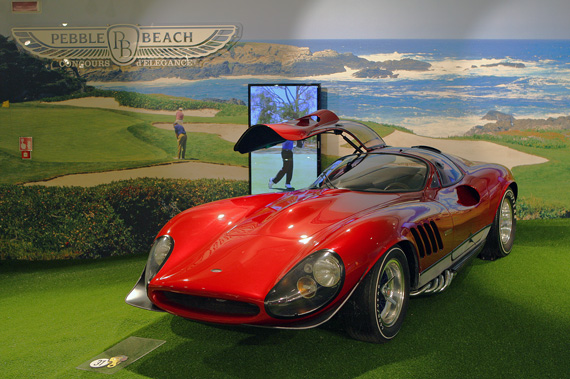
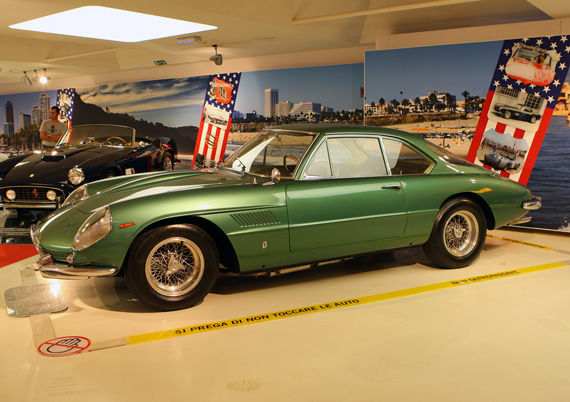
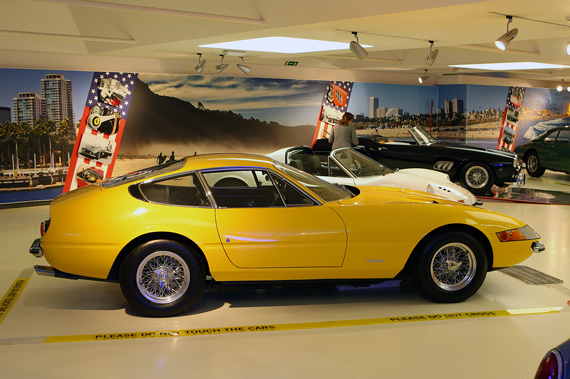
Your report contains the oft repeated theory that the Ferrari engine designed for the proposed CART entry lived on in the Alfa Romeo Indycar. Lancia had developed a 2.6 litre V8 for the group C cars which in turn had been derived from the production Ferrari 3.0 litre V8. This was the starting point of the Ferrari CART engine, but they soon found turbocharging it and converting it to run on methanol was not so easy. While the existence of the cancelled project may have been a spur for Alfa, who wanted out of F1 and an increased visibility in the USA, further testing and development led to an all new engine with very little in common with the Ferrari which was overweight and underpowered even by mid-eighties standards and would certainly have been a no-hoper by 1990. An Ilmor Chevrolet engine was even smuggled over to Italy for inspection but the Alfa did not get much further than an embarrassing white elephant before it too was canned. I was there!
The Ferrari plan to race in CART was possibly a real threat, possibly a bluff, only the late Enzo himself knows how far he would have pushed, but the disagreement was with the new rules for F1 to be introduced in 1989 (not 1986 as stated above) for the new normally aspirated 3.5 litre engines to replace the then current turbos. FISA and FOCA were close to agreeing on limiting engine design to a V8 formula and Ferrari insisted they should be able use their favoured V12 format which of course they eventually did. This year has seen similar wrangling over F1 engine rules with more disagreements and threats – some things never change!
Great to see our old 166 MM at the Ferrari museum! Dad found that car in a warehouse in 1965 and purchased it with its cracked block for $1000. He restored it and took it to the 1966 Ferrari Club Of America national meet in Indy where he won the cup for best roadster, I’m looking at the cup right now! Thanks Pete for yet another fantastic article on VT! Here is a link to photos of the car when we owned and before that. http://www.cliffreuter.com/ferrari.htm#166
Anybody remember that when a new Tom Meade design came out, people would point at it and laugh? But Tom is (was?) a neat guy and his mother was the traditional “absolute hoot.” A milder Phyllis Diller, so to say.
I had a chance to buy one of Tom Meade’s first rebodied Ferraris, a Lusso that was in a garage in Hilo, Hawaii about 10-12 years ago. I made a ridiculously low offer, someone with more vision than me made a higher ridiculously low offer and bought the car. It appeared not long after for sale after a simple freshening for a then huge price.
My last chance to own a Ferrari classic came and past. Thanks Pete for this outstanding photo essay
The best english-language report on the web, by far, for this fabulous exhibit (which is to run through January 2015), but where are the photos of the “Driver’s Wall ?” Shelby/Gurney/Ginther/Hudson/Paravanno/McAfee/(Chinetti)/Bondurant/Andretti…even Paul Newman, and Phil Hill, for Enzo’s sake! The Great Ones who booted Ferraris to glory in California have an arresting photomontage filling a curving wall, the mural being, arguably, the very quintessence of the exhibit, and you don’t show it!
Kudos, nevertheless.